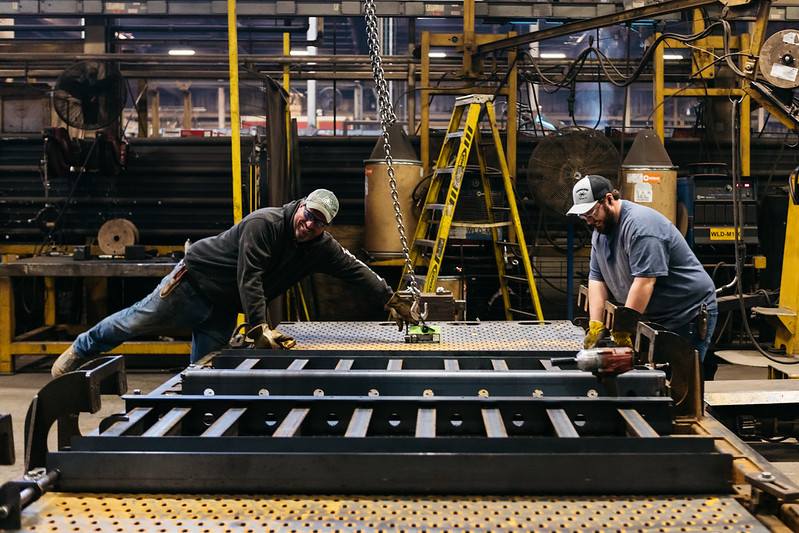In celebrating Earth Day, AEM is committed to addressing societal and safety issues on behalf of the industry. And together with our member companies, we recognize that social and environmental challenges are complex and require transformation at all levels of an organization.
Our industry is committed to supporting a sustainable world by serving as a catalyst for conversation and innovation in the equipment manufacturing industry. By transcending traditional norms, we are working to spark ideas for setting sustainability priorities for our industry and providing a framework that supports best practices for a more viable world. Learn more.
Water is a vital natural resource in many respects, one of which is the production of food. So, when people think about “sustainable water use” in the agriculture industry, it’s not simply about using less water.
“Farmers are already being sustainable,” said Tyler Fields, senior director of global water delivery at AEM member company Valley Irrigation. “Now there are new practices and technologies to really help move sustainability forward. As we move into a new era of irrigation, the big push is to take the water we have and utilize it better to grow more crops.”
“Water reduction and water efficiency are two different conversations,” added Jim Ed Beach, U.S Commercial Lead for Sustainable Solutions at Netafim USA. “Growers are trying to be more efficient. If we had more funding through the Environmental Quality Incentives Program (EQIP), I think there would be a lot more conversion to more efficient technologies.”
Fields and Beach, along with representatives of two other irrigation product manufacturers, gathered to discuss sustainable water use at AEM’s second Celebration of Modern Agriculture on the National Mall in Washington, D.C. It’s a topic that’s been getting a lot more attention in recent years due to concerns over depleting aquifers and river flows in some locations, such as the lower Colorado River.
“The lower Colorado has been an urgent, reactive situation,” said another panelist, Mike Mills, director of sustainability solutions at AEM member company Reinke Manufacturing. “Now, when we look at some of the other river basins across the country, we’re starting to say, ‘Maybe we need to pay a little more attention.’ So, there’s starting to be some proactive attention around sustainable efforts and where the water is going.”
According to fellow panelist Jason Parker, director of sales and marketing at AEM member company Lindsay Corporation, more efficient irrigation equipment can play a pivotal role in sustainable water use – all while helping to ensure a reliable global food supply.
“Looking back 30 or 40 years ago, a grower thought they were being efficient with their watering because they could see water running into the ditch at the end of the field,” Parker said. “Now growers are utilizing weather stations and soil moisture sensors. They are working off of soil moisture maps off of forecasts. There is so much more we can do today to control when and where water is applied.”
Sustainability is everyone’s business. Whether it is through minimizing operational impact on the environment, aligning with ever-evolving regulations, or supporting a more sustainable world, the equipment manufacturing industry’s future depends on the responsible use of natural resources. Learn more at aem.org/sustainability.
“Farmers are already being sustainable. Now there are new practices and technologies to really help move sustainability forward. As we move into a new era of irrigation, the big push is to take the water we have and utilize it better to grow more crops.” -- Valley Irrigation's Tyler Fields
Gaining Growers’ Trust in New Technologies
As the emphasis on sustainable water use has ramped up over the past decade or so, manufacturers that have specialized in irrigation system hardware have also been thrust into the tech arena.
“We have to remember that the center pivot is what makes it happen,” Fields said in reference to the widely utilized style of irrigation system. “What can we add to that pivot to make it better for the crop and the farmer? With the technology coming out with our scheduling platforms, farmers are able to look at what the pivot is doing on a daily basis. They can change the speed and put down a different application rate. If there’s a low spot, you want it to go a bit faster. If there’s a sandy spot, you want to slow it down and add a little more water. Efficiency is putting water where it needs to be to help produce more crop.”
Bringing these high-efficiency, technology-driven irrigation systems to market has required a mindset shift from manufacturers. Mills said it’s an easy shift to make. “We can always hire electrical engineers and software engineers who understand what we’re trying to do,” Mills pointed out.
Getting farmers to embrace the mindset shift is actually the tougher task. “The biggest challenge in the rollout has been adoption at the end-user stage, getting farmers to trust that the technology is going to do what we say it’s going to do,” Mills said.
“We have to get farmers to understand that we have the equipment to help them not only be more efficient and productive, but more sustainable,” Fields added. “The last piece to increasing adoption is the ability to have cost share on some of these innovations. Then we can really prove that if we get in the field, there is a return on investment.”
In many instances, it’s helpful when a grower starts slow. Testing a piece of equipment for a year or so can allow them to see how it works and what the benefits can be.
“The grower’s reaction comes at the end of that year when they call and say, ‘I just did the math on my yield and income. Whatever it was you put on that machine, I need it for the rest of them,’” Mills said. “The American farmer is the ultimate businessman. They know where every penny goes. If they can’t turn one penny into two, they won’t make that investment.”
Attention AEM members: Want to help AEM raise awareness of the equipment manufacturing industry’s contributions to a more sustainable world? Join our Positive Perceptions Workstream.
“Looking back 30 or 40 years ago, a grower thought they were being efficient with their watering because they could see water running into the ditch at the end of the field. Now growers are utilizing weather stations and soil moisture sensors. They are working off of soil moisture maps off of forecasts. There is so much more we can do today to control when and where water is applied.” -- Lindsay Corporation's Jason Parker
Arming Lawmakers With the Right Information
As Beach touched on earlier, government incentives can help encourage growers to make new investments. But the incentives must be based on the proper outcomes.
“Only 20% of U.S. farmland is irrigated, yet it produces over half the yield,” Fields pointed out. “That’s a pretty staggering number. The only way we’ll be able to become more productive moving forward, so we’re able to feed the next 5 to 7 billion, is to have water to put on the crop.”
Calling attention to the industry’s efficiency and productivity doesn’t mean a parallel story about water conservation can’t also be shared. Lawmakers and regulators need to be made aware of substantiating data that supports that claim.
“Since 2018, we’ve calculated that we’ve helped save 469 billion gallons of water because of our technology,” Parker said in reference to Lindsay’s products like remote system monitoring and control, flow meters, and soil moisture monitoring.
“In the last 50 years, irrigated farmland has cut its water use per acre by 25%,” Mills added. “Yet, the industry has continued to increase the yield that comes off that acre. One of the messages for lawmakers is that sustainability means more than pumping less water, because worldwide demand for food and fiber is also increasing. We must be capable of feeding and clothing the population. Then we can recalculate the way support programs work so we’re investing in things that drive high yield for minimal input, not just providing rewards for less pumping.”
Mills also pointed to the need for the agriculture industry to remain flexible in how water is managed based on availability. That requires a deep regional examination of things like crop rotations and planting styles. Those insights can help the agriculture industry capitalize when there is a water abundance in a particular region, and to adjust when there is a water deficiency.
Then it all comes back to where growers are putting the water, how much, and to what effect.
“We’re no longer managing the water that’s on the surface like was done in the past,” Mills said. “Now we’re managing the water in the soil. Until recently, we haven’t had a good way to do that other than by scientific guess. With the advent and continued development of underground moisture and nutrient sensors, we can monitor water at the root zone, which is where it ultimately matters to the plant.”
“We now have the technologies to help show that we’re being smart with our irrigation,” Fields added. “A farmer can look at some sort of irrigation scheduling platform on their tablet to see exactly what’s going on in the field. The whole point is to make sure we’re putting down the right amount of water. We want to use just enough water to be more productive.”
“We’re no longer managing the water that’s on the surface like was done in the past. Now we’re managing the water in the soil. Until recently, we haven’t had a good way to do that other than by scientific guess. With the advent and continued development of underground moisture and nutrient sensors, we can monitor water at the root zone, which is where it ultimately matters to the plant.” -- Reinke Manufacturing's Mike Mills
Learn More
Want more information on best practices, tools, programs, and resources to help initiate lasting change to protect the environment, align with evolving regulations, and accelerate the ability to remain competitive and sell products globally? Visit AEM's Sustainability Toolkit.





